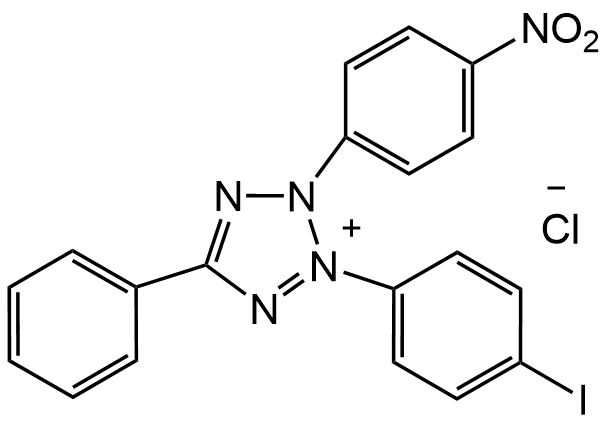
Chemical Structure
Iodonitrotetrazolium chloride
CDX-I0007
CAS Number146-68-9
Product group Chemicals
Estimated Purity>97%
Overview
- SupplierChemodex
- Product NameIodonitrotetrazolium chloride
- Delivery Days Customer10
- CAS Number146-68-9
- CertificationResearch Use Only
- Estimated Purity>97%
- Scientific DescriptionChemical. CAS: 146-68-9. Formula: C19H13IN5O2 . Cl. MW: 505.7. Soluble in methanol (10mg/ml), ethanol (30mg/ml) or water (10mg/ml). Iodonitrotetrazolium chloride (INT) is used as an indicator dye. It is reduced by cellular activity to a red-colored formazan precipitate and used as a vital dye or indicator of cellular redox activity. INT is used in cell viability assays. Living cells with active metabolic processes can reduce INT to the red formazan. INT can also be used as an indicator of cellular redox activity. The reduction process reflects the cells ability to transfer electrons, providing insights into their metabolic state. Reduction commonly results from the activity of dehydrogenases, although non-enzymatic electron transfer reactions can occur in the presence of an intermediate electron acceptor. This property of INT is used in various diagnostic assays (hematology/). INT is commonly used to measure the respiratory activity of microorganisms in a variety of contexts. The maximum absorption wavelength (lambdamax) of INT (unreduced) is ~248nm. The reduced formazan (red) has a lambdamax ~490-520nm. - Iodonitrotetrazolium chloride (INT) is used as an indicator dye. It is reduced by cellular activity to a red-colored formazan precipitate and used as a vital dye or indicator of cellular redox activity. INT is used in cell viability assays. Living cells with active metabolic processes can reduce INT to the red formazan. INT can also be used as an indicator of cellular redox activity. The reduction process reflects the cells ability to transfer electrons, providing insights into their metabolic state. Reduction commonly results from the activity of dehydrogenases, although non-enzymatic electron transfer reactions can occur in the presence of an intermediate electron acceptor. This property of INT is used in various diagnostic assays (hematology/). INT is commonly used to measure the respiratory activity of microorganisms in a variety of contexts. The maximum absorption wavelength (lambdamax) of INT (unreduced) is ~248nm. The reduced formazan (red) has a lambdamax ~490-520nm.
- Storage Instruction2°C to 8°C,RT
- UNSPSC41116134


![INT [146-68-9]](https://www.targetmol.com/group3/M00/37/B7/CgoaEGayULaEYTaMAAAAALOfI7s662.png)